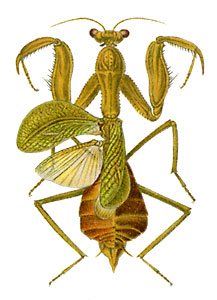
Mantidae is one of the largest families in the order of praying mantises, based on the type species Mantis religiosa; however, most genera are tropical or subtropical. Historically, this was the only family in the order, and many references still use the term "mantid" to refer to any mantis. Technically, however, "mantid" refers only to members of the family Mantidae, and not the 14 remaining families of mantises. Some of the most recent classifications have promoted a number of the mantid subfamilies to the rank of family, e.g. Iridopterygidae, Sibyllidae, Tarachodidae, Thespidae, and Toxoderidae, while other classifications have reduced the number of subfamilies without elevating to higher rank.

Hymenopodidae is a family of the order Mantodea (mantises), which contains six subfamilies. Some of the species in this family mimic flowers and are found camouflaged among them; these are called flower mantises. Their coloration is aggressive mimicry, luring prey to approach close enough to be seized and eaten.

Miomantis caffra is a species of praying mantis native to southern Africa. It appeared in New Zealand in 1978, and was found more recently in Portugal and Los Angeles, USA, likely spread through the exotic pet trade. Females are facultatively parthenogenetic and unmated females can produce viable offspring.

Hymenopodinae is a subfamily of the mantis family Hymenopodidae that includes several species of flower mantises.
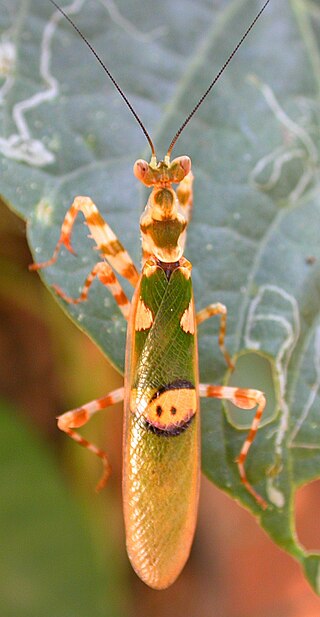
Creobroter is a genus of flower mantises in the tribe Hymenopodini; species are concentrated in Asia. The name comes from the Greek kreo-, meaning "flesh") and broter" meaning "eating", therefore, "flesh-eating", an apt name for a predatory insect. Both sexes have long wings and are capable fliers. Full-grown males are about 3 to 4 cm in length; females are about 4 to 5 cm.

Oxypilinae is a subfamily of the mantis family Hymenopodidae.

The burying mantis is a species of mantis native to Australia. They are grey/brown or green, frequently with mottled patterning on the wings, and a have distinctive pale tubercles on the forelegs. Both sexes can reach lengths of up to 70 mm long. Their common name comes from the behaviour of females, which infrequently bury their oothecae underground.

Archimantis is a genus of praying mantis found in Australia. These species are ranging from 150 mm to 180mm, and can be quite aggressive when full adult.

Tenodera angustipennis is a species of mantis native to Asia and nearby areas of Oceania. The species was introduced and became established in the eastern United States. Tenodera angustipennis was noticed as early as 1921 in Aberdeen, Maryland, but that occurrence was not noted in a published record until 1933.

Sphodromantis gastrica, with the common names African mantis or common green mantis, is a species of praying mantis from Africa.
Cilnia chopardi is a species of praying mantis in the family Miomantidae.
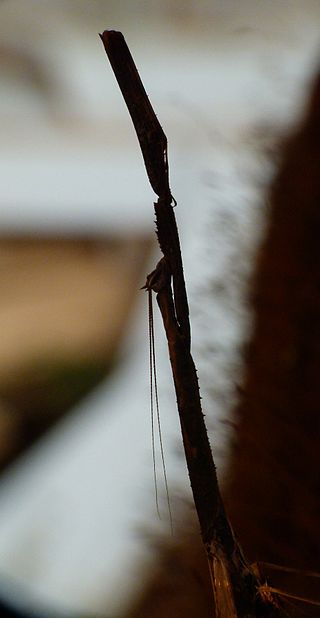
Toxoderidae is a family of praying mantises.
Tarachodes afzelii, commonly known as the Tanzanian ground mantis, is a species of praying mantis in the family Eremiaphilidae. It is native to woodland in Western and Central Africa.
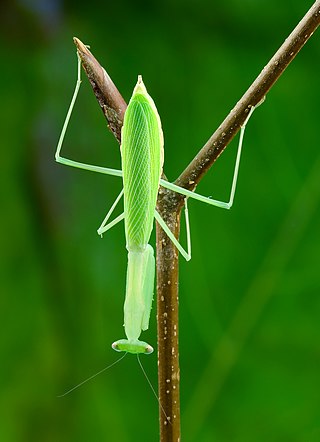
Miomantidae is a family of praying mantises in the order Mantodea.

Statilia is a genus of praying mantis that resembles dead or living grass. Statilia species live in Australia, Africa, Asia and islands.
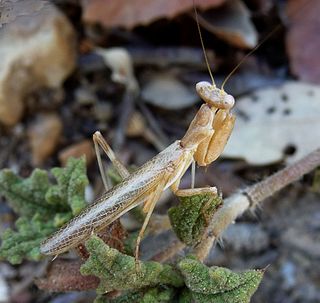
The mantis family Amelidae was previously placed in the family Mantidae. Species have been recorded from Africa, Asia, Europe and North America.

Pseudovates is a genus of praying mantis in the family Mantidae. There are more than 20 described species in the genus Pseudovates, and are found in North, Central, and South America.

The Hierodulinae are a subfamily of praying mantids, originally used by Brunner von Wattenwyl. It was restored as part of a major revision of mantid taxonomy, and now contains genera previously placed elsewhere in the family Mantidae.
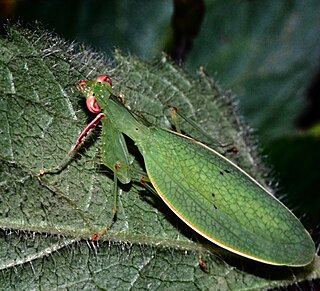
The Nanomantidae are a new (2019) family of praying mantises, based on the type genus Nanomantis. As part of a major revision of mantid taxonomy, genera and tribes have been moved here, substantially replacing the old family Iridopterygidae.
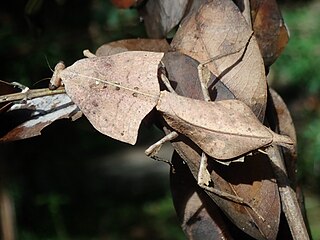
The Deroplatyidae are a new (2019) family of praying mantises, based on the type genus Deroplatys. As part of a major revision of mantis taxonomy, the subfamily Deroplatyinae has been moved here from the previously-structured family Mantidae.
